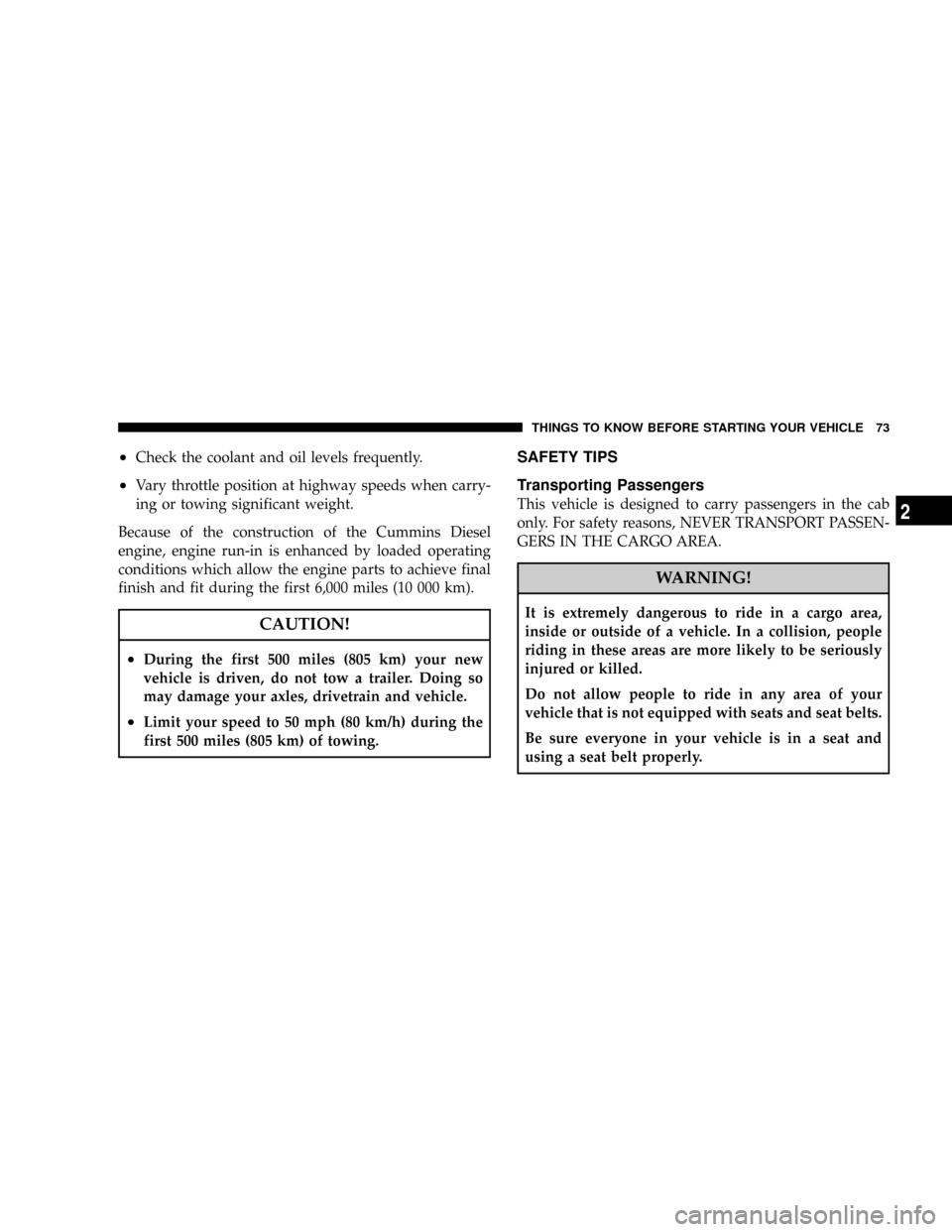DODGE RAM 4500 CHASSIS CAB 2008 3.G Manual PDF
Manufacturer: DODGE, Model Year: 2008, Model line: RAM 4500 CHASSIS CAB, Model: DODGE RAM 4500 CHASSIS CAB 2008 3.GPages: 528, PDF Size: 7.84 MB
Page 71 of 528

Children Too Large for Booster Seats
Children who are large enough to wear the shoulder belt
comfortably, and whose legs are long enough to bend
over the front of the seat when their back is against the
seat back should use the lap/shoulder belt in a rear seat.
²Make sure that the child is upright in the seat.
²The lap portion should be low on the hips and as snug
as possible.
²Check belt fit periodically. A child's squirming or
slouching can move the belt out of position.
If the shoulder belt contacts the face or neck, move the
child closer to the center of the vehicle. Never allow a
child to put the shoulder belt under an arm or behind
their back.
NEW ENGINE BREAK-IN
5.7L Gas Engine
A long break-in period is not required for the engine in
your new vehicle. Drive moderately during the first 300
miles (500 km). After the initial 60 miles (100 km), speeds
up to 50 or 55 mph (80 or 90 km/h) are desirable. While
cruising, brief full-throttle acceleration, within the limits
of local traffic laws, contributes to a good break-in.
Avoid wide open throttle acceleration in low gear.
The engine oil installed in the engine at the factory is a
high quality, energy conserving type lubricant. Oil
changes should be consistent with the anticipated cli-
matic conditions under which vehicle operation will
occur. The recommended viscosity and quality grades are
discussed in Section 7 under Maintenance Procedures,
Engine Oil.
THINGS TO KNOW BEFORE STARTING YOUR VEHICLE 71
2
Page 72 of 528

NON-DETERGENT OR STRAIGHT MINERAL OILS
MUST NEVER BE USED.
A new engine may consume some oil during its first few
thousand miles of operation. This is a normal part of the
break-in and is not an indication of difficulty.
CAUTION!
²During the first 500 miles (805 km) your new
vehicle is driven, do not tow a trailer. Doing so
may damage your axles, driveline and vehicle.
²Limit your speed to 50 mph (80 km/h) during the
first 500 miles (805 km) of towing.
6.7L Diesel Engine
Your Cummins 24 Valve Turbo Diesel engine does not
require a break-in period due to its construction. Normal
operation is allowed, provided the following recommen-
dations are followed:
NOTE:Light duty operation such as light trailer towing
or no load operation, will extend the time before the
engine is at full efficiency and may effect the performance
of the vehicle aftertreatment (exhaust) system. Reduced
fuel economy and power may be seen at this time.
²Warm up the engine before placing it under load.
²Do not operate the engine at idle for prolonged
periods.
²Use the appropriate transmission gear to prevent
engine lugging.
²Observe vehicle oil pressure and temperature indica-
tors.
72 THINGS TO KNOW BEFORE STARTING YOUR VEHICLE
Page 73 of 528

²Check the coolant and oil levels frequently.
²Vary throttle position at highway speeds when carry-
ing or towing significant weight.
Because of the construction of the Cummins Diesel
engine, engine run-in is enhanced by loaded operating
conditions which allow the engine parts to achieve final
finish and fit during the first 6,000 miles (10 000 km).
CAUTION!
²During the first 500 miles (805 km) your new
vehicle is driven, do not tow a trailer. Doing so
may damage your axles, drivetrain and vehicle.
²Limit your speed to 50 mph (80 km/h) during the
first 500 miles (805 km) of towing.
SAFETY TIPS
Transporting Passengers
This vehicle is designed to carry passengers in the cab
only. For safety reasons, NEVER TRANSPORT PASSEN-
GERS IN THE CARGO AREA.
WARNING!
It is extremely dangerous to ride in a cargo area,
inside or outside of a vehicle. In a collision, people
riding in these areas are more likely to be seriously
injured or killed.
Do not allow people to ride in any area of your
vehicle that is not equipped with seats and seat belts.
Be sure everyone in your vehicle is in a seat and
using a seat belt properly.
THINGS TO KNOW BEFORE STARTING YOUR VEHICLE 73
2
Page 74 of 528

Lock Your Vehicle
Always remove the keys from the ignition and lock all
doors when leaving the vehicle unattended, even in your
own driveway or garage. Try to park your vehicle in a
well-lighted area and never invite theft by leaving ar-
ticles of value exposed.
Exhaust Gas
WARNING!
Exhaust gases contain carbon monoxide, a potentially
toxic gas that by itself is colorless and odorless. To
avoid inhaling these gases, the following precautions
should be observed:
²Do not run the engine in a closed garage or in confined
areas any longer than needed to move your vehicle in
or out of the area.
²If it is necessary to sit in a parked vehicle with the
engine running for more than a short period, adjust
your climate control system to force outside air into
the vehicle. Set the blower at high speed and the
controls in any position except OFF or MAX A/C.
²The best protection against carbon monoxide entry
into the vehicle body is a properly maintained engine
exhaust system.
Be aware of changes in the sound of the exhaust system;
exhaust fumes detected inside the vehicle; or damage to
the underside or rear of the vehicle. Have a competent
mechanic inspect the complete exhaust system and adja-
cent body areas for broken, damaged, deteriorated or
mispositioned parts. Open seams or loose connections
could permit exhaust fumes to seep into the passenger
compartment. In addition, inspect the exhaust system
each time the vehicle is raised for lubrication or oil
change. Replace or adjust as required.
74 THINGS TO KNOW BEFORE STARTING YOUR VEHICLE
Page 75 of 528

Safety Checks You Should Make Inside The
Vehicle
Heater Defroster Ducts
Inspect the heater defroster ducts for proper operation.
Check for proper air flow through all defroster ducts. If
there are any question regarding the operation of your
heater defroster ducts, have the system checked by an
authorized dealer
Seat Belts
Inspect the belt system periodically, checking for cuts,
frays and loose parts. Damaged parts must be replaced
immediately. Do not disassemble or modify the system.
Seat belt assemblies must be replaced after an accident if
they have been damaged (bent retractor, torn webbing,
etc.) or if the front airbags have deployed. If there is any
question regarding belt or retractor condition, replace the
belt.
Airbag Light
The light should come on and remain on for 6 to 8
seconds as a bulb check when the ignition switch is first
turned ON. If the light is not lit during starting, see your
authorized dealer. If the light stays on, flickers or comes
on while driving, have the system checked by an autho-
rized dealer. If there is a problem with the airbag light the
seatbelt light will flash.
Safety Checks You Should Make Outside The
Vehicle
Tires
Examine tires for tread wear or uneven wear patterns.
Check for stones, nails, glass or other objects lodged in
the tread.
Inspect for tread cuts or sidewall cracks. Check wheel
nuts for tightness and tires for proper pressure.
THINGS TO KNOW BEFORE STARTING YOUR VEHICLE 75
2
Page 76 of 528

Lights
Check the operation of all exterior lights. Check turn
signal and high beam indicator lights on the instrument
panel.
Door Latches
Check for positive closing, latching and locking.
Fluid Leaks
Check area under vehicle after overnight parking for fuel,
water, oil, or other fluid leaks. Also, if fuel fumes are
detected the cause should be located and corrected.
76 THINGS TO KNOW BEFORE STARTING YOUR VEHICLE
Page 77 of 528

UNDERSTANDING THE FEATURES OF YOUR VEHICLE
CONTENTS
mMirrors...............................81
NInside Mirror.........................81
NAutomatic Dimming Mirror ± If Equipped....82
NOutside Mirrors.......................82
NExterior Mirrors Folding Feature...........83
NElectronic Power Mirrors ± If Equipped......84
NElectric Rear Window Defroster And Heated
Sideview Mirrors ± If Equipped............85
NTrailer Towing Mirrors ± If Equipped........85mHands±Free Communication (UConnectŸ) Ð
If Equipped............................87
NOperations...........................89
NPhone Call Features....................96
NUConnectŸ System Features..............99
NAdvanced Phone Connectivity............103
NThings You Should Know About Your
UConnectŸ System....................106
NGeneral Information...................113
3
Page 78 of 528

mSeats................................114
N40-20-40 Front Seat....................114
NReclining Seats.......................115
NAdjustable Head Restraints..............116
NManual Rotary Lumbar Support Adjustment Ð
If Equipped.........................117
NPower Seats Ð If Equipped..............117
NHeated Seats Ð If Equipped.............119
mTo Open And Close The Hood.............120
mLights...............................122
NInterior Lights.......................122
NBattery Saver........................123
NHeadlamp Delay......................124
NHeadlights, Parking Lights, Panel Lights.....124NDaytime Running Lights
(Canada Only And Fleet Vehicles)..........125
NLights-On Reminder...................125
NFog Lights Ð If Equipped...............125
NMultifunction Control Lever..............126
mWindshield Wipers And Washers............128
NWindshield Wipers....................128
NWindshield Washers...................129
mTilt Steering Column....................130
mDriver Adjustable Pedals Ð If Equipped......131
NAdjustment.........................131
mElectronic Speed Control Ð If Equipped......132
NTo Activate..........................133
NTo Set At A Desired Speed...............133
78 UNDERSTANDING THE FEATURES OF YOUR VEHICLE
Page 79 of 528

NTo Deactivate........................133
NTo Resume Speed.....................133
NTo Vary The Speed Setting...............133
NTo Accelerate For Passing...............134
mOverhead Console With Compass/Temperature
Mini-Trip Computer Ð If Equipped..........135
NUS/M Button........................135
NReset Button.........................136
NGlobal Reset.........................136
NStep Button.........................136
NAverage Fuel Economy (AVG ECO)........137
NDistance To Empty (DTE)...............137
NTrip Odometer (ODO)..................138NElapsed Time (ET).....................138
NC/T Button.........................139
NAutomatic Compass Calibration...........139
NManual Compass Calibration.............140
NRecalibrating The Compass..............140
NOutside Temperature...................141
mOverhead Console With Electronic Vehicle
Information Center (EVIC) Ð Diesel Only.....142
NDome/Reading Lights..................142
NElectronic Vehicle Information Center (EVIC) Ð
If Equipped.........................143
NCompass/Temperature Button............148
mElectrical Power Outlets..................151
mCigar Lighter And Ash Receiver............152
UNDERSTANDING THE FEATURES OF YOUR VEHICLE 79
3
Page 80 of 528

mCupholders...........................154
NFront Instrument Panel Cupholders (40±20±40
Seats) Ð Automatic Transmission..........154
NFront Instrument Panel Cupholders
(Bucket Seats) Ð Automatic Transmission....155
NFront Instrument Panel Cupholders Ð Manual
Transmission........................156
NRear Cupholder (Quad Cab) Ð If Equipped . . 156
mStorage..............................157
NCenter Storage Compartment (40±20±40 Seat) Ð
If Equipped.........................157NCenter Storage Compartment (Bucket Seats) Ð
If Equipped.........................158
NStorage And Seats (Quad Cab Models)......160
NPlastic Grocery Bag Retainers.............161
mRear Window Features...................161
NElectric Rear Window Defroster And Heated
Side View Mirrors Ð If Equipped..........161
NPower Sliding Rear Window Ð If Equipped . . 162
NSliding Rear Window Ð If Equipped.......162
mFold Flat Load Floor Ð If Equipped.........163
80 UNDERSTANDING THE FEATURES OF YOUR VEHICLE